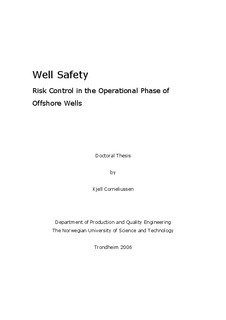| dc.contributor.author | Corneliussen, Kjell | nb_NO |
| dc.date.accessioned | 2014-12-19T11:20:06Z | |
| dc.date.available | 2014-12-19T11:20:06Z | |
| dc.date.created | 2008-01-31 | nb_NO |
| dc.date.issued | 2006 | nb_NO |
| dc.identifier | 123413 | nb_NO |
| dc.identifier.isbn | 82-471-7839-7 | nb_NO |
| dc.identifier.uri | http://hdl.handle.net/11250/227935 | |
| dc.description.abstract | The main objective of this thesis has been the development of procedures and methods for risk assessment of oil and gas wells. The work is limited to the well operational phase. The procedures and methods provide status of the well risk level during the life cycle from installation to abandonment of the well. The main focus is on the two main safety functions of the well:
a. To prevent uncontrolled leakage of well fluids from the well to the environment. This function is usually referred to as well integrity and is a continuous safety function that may fail at any instant of time.
b. To shut in the well flow in case of a dangerous incident on the downstream side of the x-mas tree. The shut-in function is an on demand function activated in a random critical situation.
In this context a systematic approach means to describe a procedure for risk assessment, with focus on quantitative/predictive analysis as a means to provide input to the assessment. The risk assessment is based on existing and new methods and knowledge gained during the PhD work.
The following contributions from the thesis are identified:
• A systematic approach for well risk assessment in the operational phase. A set of WRFs are identified that influence the total well risk. The procedure is primarily aimed at risk assessment in the operational phase after a well component failure has occurred.
• A method for constructing barrier diagrams. A barrier diagram is a structured way of describing a well as a barrier system. In the thesis it is shown how to calculate failure probability directly from the barrier diagram. Alternatively, the barrier diagram construction rules allows for converting the barrier diagram to a fault tree.
• A framework for assessing well component failure causes, acceptable deviations in well component performance, and dependent failures.
• A method for calculating the safety unavailability of safety functions, and a method for calculating the safety unavailability for different configurations of surface controlled subsurface safety valves. | nb_NO |
| dc.language | eng | nb_NO |
| dc.publisher | Fakultet for ingeniørvitenskap og teknologi | nb_NO |
| dc.relation.ispartofseries | Doktoravhandlinger ved NTNU, 1503-8181; 2006:47 | nb_NO |
| dc.relation.haspart | Corneliussen, Kjell. Approaches to the determinations of safety integrity levels (SIL) for Safety Instrumented Systems (SIS); comparison and discussion. The Third Edinburgh Conference on RISK: Analysis, Assessment and Management, 2002. | nb_NO |
| dc.relation.haspart | Hokstad, Per; Corneliussen, Kjell. Loss of safety assessment and the IEC 61508 standard. Reliability Engineering and System Safety. 83: 111-120, 2004. | nb_NO |
| dc.relation.haspart | Corneliussen, Kjell; Sklet, Snorre. Challenges related to surveillance of safety functions. European Safety and Reliability Conference (ESREL), 2003. | nb_NO |
| dc.relation.haspart | Corneliussen, Kjell. Barrier diagram of oil/gas wells - construction rules. . | nb_NO |
| dc.relation.haspart | Corneliussen, Kjell; Rausand, Marvin. Reliability assessment of surface controlled subsurface safety valves. . | nb_NO |
| dc.title | Well Safety. Risk Control in the Operational Phase of Offshore Wells | nb_NO |
| dc.type | Doctoral thesis | nb_NO |
| dc.contributor.department | Norges teknisk-naturvitenskapelige universitet | nb_NO |
| dc.description.degree | dr.ing. | nb_NO |
| dc.description.degree | dr.ing. | en_GB |
